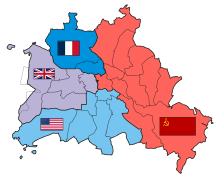Berlin Senior Citizens' Convention (KSCV)
The Berliner SC is the senior citizens' convent (university) of the Kösener Corps in Berlin .
history
After the opening of the Alma Mater Berolinensis in 1810, five Landsmannschaften (Corps) formed the first Berliner SC:
- the Marchia, which is continued by the Frankfurter Märkern, for the students mainly from the Mark Brandenburg
- a guestphalia for the other German students
- since 1811 a Vandalia for the Mecklenburg people
- a pomerania for the pomeranians
- a Silesia for the Silesian students
As the second rector of the university, Johann Gottlieb Fichte had already taken a sharp position in his inaugural speech against student orders and country teams, especially against their "duels"; but he could not enforce his anti-corporate line and resigned resignedly. Many active fought in the wars of liberation . The disputes with the original fraternity and the Karlovy Vary resolutions often led to suspensions, reconstitutions and the founding of individual corps. Composed differently, a strong SC did not exist again until around 1840, to which the following corps belonged in the Empire and in the Weimar Republic in the order determined by the SC (foundation year in brackets): Marchia (1810), Guestphalia (1845), Vandalia (1851), Normannia (1842), Teutonia (1866), Borussia (1873) and Neoborussia (1838). After the politically forced suspension of the active corps in 1935/36, their old rulers tried ultimately unsuccessfully to continue the common SC tradition in an SC comradeship . The Pépinière-Corps Suevo-Borussia, which was reconstituted in Berlin in 1937 camouflaged, fought 22 lengths from 1941 to 1943 against the "war markers".
In the post-war period after the Second World War in Germany , students were able to reunite in connections in the western sectors of divided Berlin : at the Technical University opened in the British sector in 1946 and at the Free University founded in the American sector in 1948 . The first SC were Marchia (reconstituted 1951) and Borussia (rec. 1952). There were also Vandalia-Teutonia (founded in 1953 by the two mother corps), Normannia (returned from Hamburg in 1953) and Guestphalia (returned from Mainz in 1955). Neoborussia was reconstituted in Darmstadt in 1952 and moved to Bochum in 1967. As the sixth corps, Lusatia Leipzig, who moved from Erlangen to Berlin in 1958, strengthened the SC until 1992. The Berliner SC joined the Corporationsring Berlin, which was founded in 1950, actively participated in its university policy, especially during the 1968 movement, and assumed its chairmanship several times. The Berliner Consenioren-Convent followed: Lusatia Leipzig from 1992 to 2002, Masovia since 2001 and Silesia Breslau zu Frankfurt (Oder) as the successor to Borusso-Silesia since 2007. The Berliner SC provided 1863, 1882, 1901, 1925, 1962, 1987 and 2013 the suburb in the Kösener SC association .
See also
literature
- Ulrich Dëus-von Homeyer (ed.): 1810–2010. 200 years of the Berlin University. 200 years of the Berlin Corps. A collection of student history works , presented to the 70th German Student History Conference, 2nd verb. Edition. Berlin 2010, self-published.
- Egbert Weiß : From the history of the Corporationsring Berlin , 4 parts in then and now :
- 31 (1986), pp. 81-102
- 32 (1987), pp. 59-88, 283
- 33: 153-181 (1988)
- 35: 219-248 (1990)
Web links
Individual evidence
- ^ Albert Marth: History of the Marchia Corps in Berlin . Berlin 1919
- ↑ Erich Bauer : News on the history of old suspended corps . Once and Now 9 (1964), p. 104 ff.
- ^ A b c Kurt Meyer: The color-bearing corporations at the Berlin University from 1810 to 1870 . Once and Now 6 (1961), p. 130 ff.
- ^ Wilhelm Weischedel : Idea and Reality of a University . Commemorative publication of the Free University of Berlin 1961, p. 231 ff.
- ↑ Harald Seewann : The German student in the years of the popular uprising 1813-1815 . Graz 1984
- ↑ Paul Gerhardt Gladen : Free Corps Marchia - a weapon-student connection at the Military Medical Academy in Berlin 1941-43 . Once and Now 50 (2005), p. 369 ff.
- ↑ E. Weiss (1986–1990)
- ^ WorldCat


